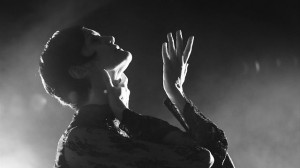Aside from a two week workshop with Dame Libby Kamaiko about 20 years ago, I don’t know much about flamenco. So for this preview, I relied on the expertise of flamenco dancer/singer/teacher Chiara Mangiameli of Studio Mangiameli to tell me about her upcoming show. We corresponded via email last week.
First, please tell me about your background. Where you grew up? When and why you started dancing?
I was born and grew up mostly in Milan, Italy but we moved often due to my father’s job so at a young age I spent time in the States and in Buenos Aires, Argentina. I started with ballet but didn’t stick with it for very long, I tried tap and realized at a young age that rhythm made sense to me. I could hear and replicate syncopated patterns pretty easily. I tried African dance as well in college but nothing really stuck until I discovered flamenco as an adult. That’s when I finally got serious about dance. I took my first flamenco class in Chicago with Michelle Nascimento who was my teacher for several years and with whom I traveled to Seville, Spain for the first time.
Tell me about your music Ensemble Idilio.
“Idilio” is a group I co-founded with my friends Diego Alonso and Kassandra Kocoshis. I had recently returned from a long stay in Seville where I had spent time studying and listening to the “cante” (flamenco singing). I had a great desire to sing at that time and work with people in Chicago that felt as passionately about that style of music as I did. I ended up incorporating my Italian background in a couple of the songs, one of which I co-wrote with my friend Carlo Basile. whom I had previously worked with in his group Las Guitarras De España.
What brought you to Chicago?
I moved with my mother the summer going into my third year of high school. I ended up going to The Theater School at De Paul University and pursuing theater.
What made you decide to open your studio?
I had been teaching flamenco classes in a couple different studios in Chicago including the Flamenco Arts Center. I had a strong student basis and started for the first time choreographing dances that we would then showcase in a small theater. I found it was a great tool to motivate the students and also give them an opportunity to work with live musicians which is how flamenco is traditionally done. At the same time I was traveling to Seville regularly to continue my education and the more I learned, the hungrier I was to teach and push the students further. Opening my own studio in June of 2011 gave me the freedom to add more classes, set my own schedule and establish my own environment and aesthetics. It also motivated me to become more creative with my student showcases starting with “A Través Del Espejo (Through The Mirror)” in 2012, and “Quejíos – Cries In The Air” which we will premier at the end of this month.
Tell me about the show. Where did the idea come from? Did you create all of the choreography and score the music?
The initial idea for the show was to showcase the “cante,” the expressive power and raw emotion of flamenco singing. Have every dance piece reflect its mood, its dynamics. I asked my friend and Madrid-based writer Luis Lorente if he would write a poem inspired by the word “Quejíos,” Andalusian slang for “cries.” Flamenco songs are often composed of small verses, poetry of the people expressing every day life. The poem seemed like a natural fit, a beautiful tool to further illustrate the soul of flamenco.
There are 32 students showcased in this new work, two Chicago based guitarists Carlo Basile and Diego Alonso who composed most of the music for the show and percussionist Bob Garrett. Our guest singer and Seville native Alfonso Cid, will lend his beautiful voice to this production. For the first time we will also be at times veering form flamenco’s tradition of live music and incorporating recorded compositions, including a modern piece by a French composer which we use for our castanet choreography. I started working on the choreographies and staging in September of last year, and consider them all a product of the teachers and dancers that have inspired me and taught me over the years. In particular, Madrid based dancer Paloma Gómez who introduced me to the beautiful language of castanets and Clasico Español.
Tell me about your new solo.
My new solo is in the rhythmic structure of “seguiriya,” a form that I’ve wanted to perform for many years. The singing is very technically demanding and since the dance is entirely based on the song, I wanted to work with a strong singer whose energy I could feed off of. This new work ties back to the “Quejíos” poem and while it displays a lot of traditional elements belonging to this dance style, it also incorporates unexpected moments from Diego Alonso’s original guitar composition.
What is a “seguiriya”?
Seguiriya belongs to the “cante jondo” category of flamenco. Best translated as “deep song,” it is one of the most somber forms in flamenco. The rhythmic structure is complex and has, in my opinion, a kind of trance-like quality to it. It is said that while gypsy blacksmiths worked they would pound out its rhythm as they sang, The themes associated with seguiriya often deal with painful loss.
Studio Mangiameli presents Quejíos – Cries In The Air at the Vittum Theater, 1012 N. Noble St., Thursday, May 31 and Friday, June 1 at 8 pm. Tickets are $25 ($15 for kids 12 and under). Buy tickets here.

